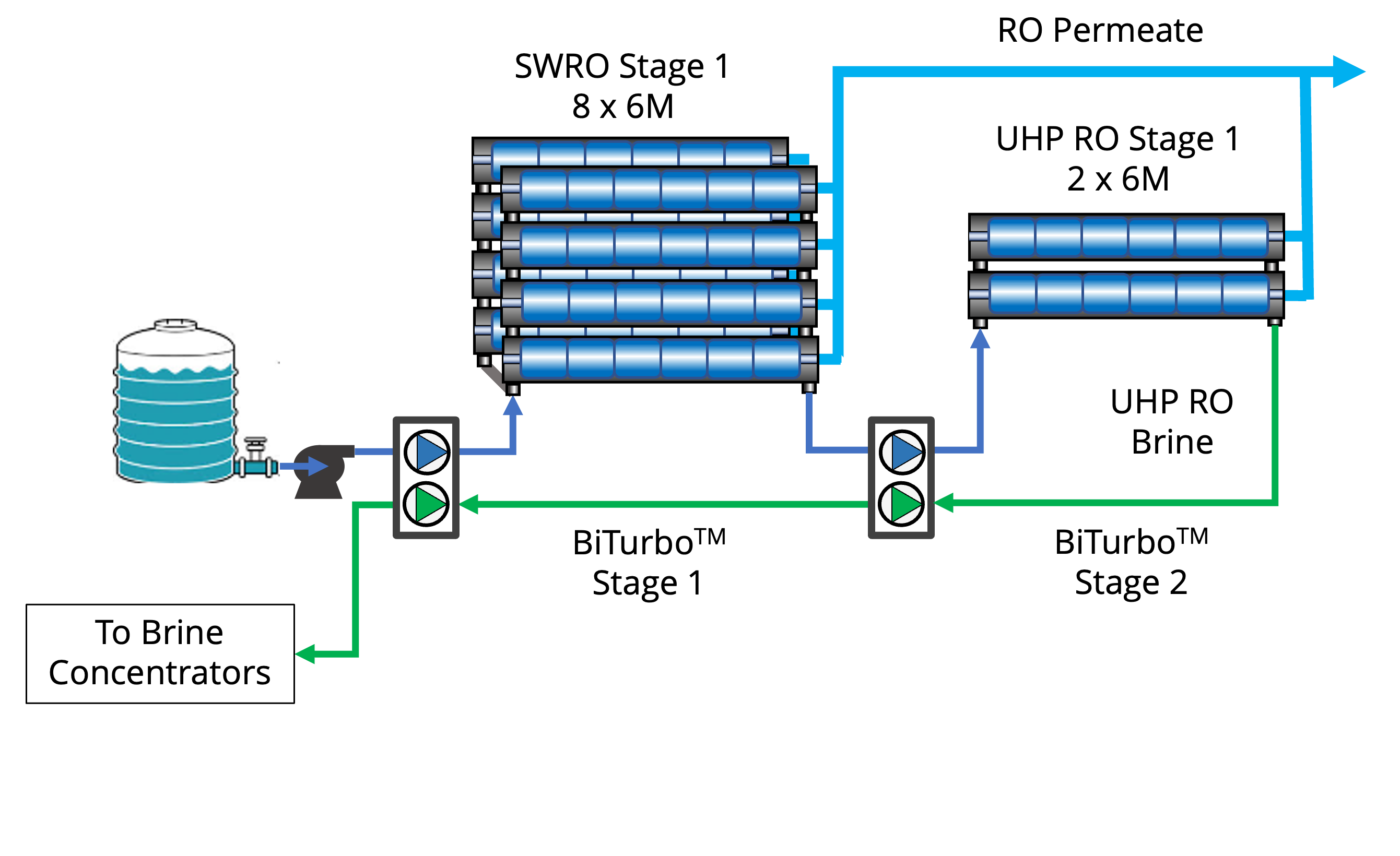Zero Liquid Discharge
Ultra-high-pressure RO for high-recovery wastewater treatment or brine mining
- Minimize brine discharge
- Reduce or eliminate evaporation requirements
- Recover valuable minerals

In a multi-stage reverse osmosis array, only the final membrane stage operates above conventional SWRO pressure (82 bar/1,200 psi).
Using an HPB-Ultra turbocharger provides this boost without requiring specialist high-pressure pumps or high-speed motors.
.png?width=180&height=170&name=HPB-500%20V1.8%20(1).png)
Growing demand for ZLD and brine mining is a new paradigm for high-recovery reverse osmosis.
Boost your ultra-high-pressure RO system safely, efficiently, and flexibly with the HPB Ultra turbocharger.
Read our case study to find out how the HPB Ultra is powering brine mining research in Saudi Arabia.
We are constructing more desalination capacity than ever, but traditional single-stage membrane arrays dominate
Small increases to recovery come at the cost of higher biofouling, higher chemical consumption and shorter membrane life
Large arrays of isobaric ERDs also struggle to maintain consistent energy transfer, and introduce brine-feed mixing
MAXIMIZE RO RECOVERY
- Reduce brine disposal costs
- Minimize evaporator size for zero liquid discharge applications
- Achieve high recovery rates with optimal membrane performance
INDUSTRY-ORIENTED DESIGN
- Maximize reliability with dynamically balanced, motor-free turbochargers
- Compact footprint to reduce impact on site operations
- Improve safety and reduce noise levels: minimize rotating parts operating under ultra-high pressure
As the push for sustainability and regulations limiting wastewater discharge volumes continue to increase, industrial water users are turning to water recycling and brine concentration through Minimal Liquid Discharge (MLD) and Zero Liquid Discharge (ZLD) facilities. Conventional approaches using evaporation are expensive, energy-intensive, and operationally challenging, making the case for maximizing recovery from waste streams more compelling than ever before.
However, achieving top brine concentrations beyond 100,000 ppm has traditionally been challenging for reverse osmosis (RO) technology. At every scale, the need for a simple and reliable solution to the membrane brine concentration challenge is clear. Let us help you push the boundaries of what RO technology can achieve.
Advantages of multi-stage, ultra-high-pressure RO using interstage turbochargers:
- Achieve top brine concentration up to 120,000 ppm without complex system configurations or challenging operating conditions
- Simple and reliable solution to the membrane brine concentration challenge
- Energy-efficient and cost-effective compared to conventional approaches using evaporation
Read the technical paper linked below to find out more about applying ultra-high-pressure turbochargers to industrial wastewater treatment and ZLD.
Find out more:
- Product specifications: text here
- Technical paper: text here
Contact our sales team to find out more about our products and services.
Interstage boosting is commonly used in brackish water reverse osmosis (BWRO) to balance flux between multiple RO stages. This achieves more stable membrane performance and higher recovery rates.
Using a turbocharger for your system's interstage boosting needs avoids using additional energy, and saves CAPEX on a booster pump, motor and variable frequency drive. It is also highly compact and operates with close to zero noise and vibration.
Interstage boosting is an ideal solution to handling high recovery applications or variable feedwater quality. See the case study below to find out more.
Find out more:
- Product specifications: Learn more about the HPB turbocharger
- Technical guide: In-depth study of centrifugal energy recovery devices
- Case study: Addressing variable feed quality using interstage boosting.
Contact our sales team to find out more about our products and services.
As the push for sustainability and regulations limiting wastewater discharge volumes continue to increase, industrial water users are turning to water recycling and brine concentration through Minimal Liquid Discharge (MLD) and Zero Liquid Discharge (ZLD) facilities. Conventional approaches using evaporation are expensive, energy-intensive, and operationally challenging, making the case for maximizing recovery from waste streams more compelling than ever before.
However, achieving top brine concentrations beyond 100,000 ppm has traditionally been challenging for reverse osmosis (RO) technology. At every scale, the need for a simple and reliable solution to the membrane brine concentration challenge is clear. Let us help you push the boundaries of what RO technology can achieve.
Advantages of multi-stage, ultra-high-pressure RO using interstage turbochargers:
- Achieve top brine concentration up to 120,000 ppm without complex system configurations or challenging operating conditions
- Simple and reliable solution to the membrane brine concentration challenge
- Energy-efficient and cost-effective compared to conventional approaches using evaporation
Read the technical paper linked below to find out more about applying ultra-high-pressure turbochargers to industrial wastewater treatment and ZLD.
Find out more:
- Product specifications: text here
- Technical paper: text here
Contact our sales team to find out more about our products and services.

